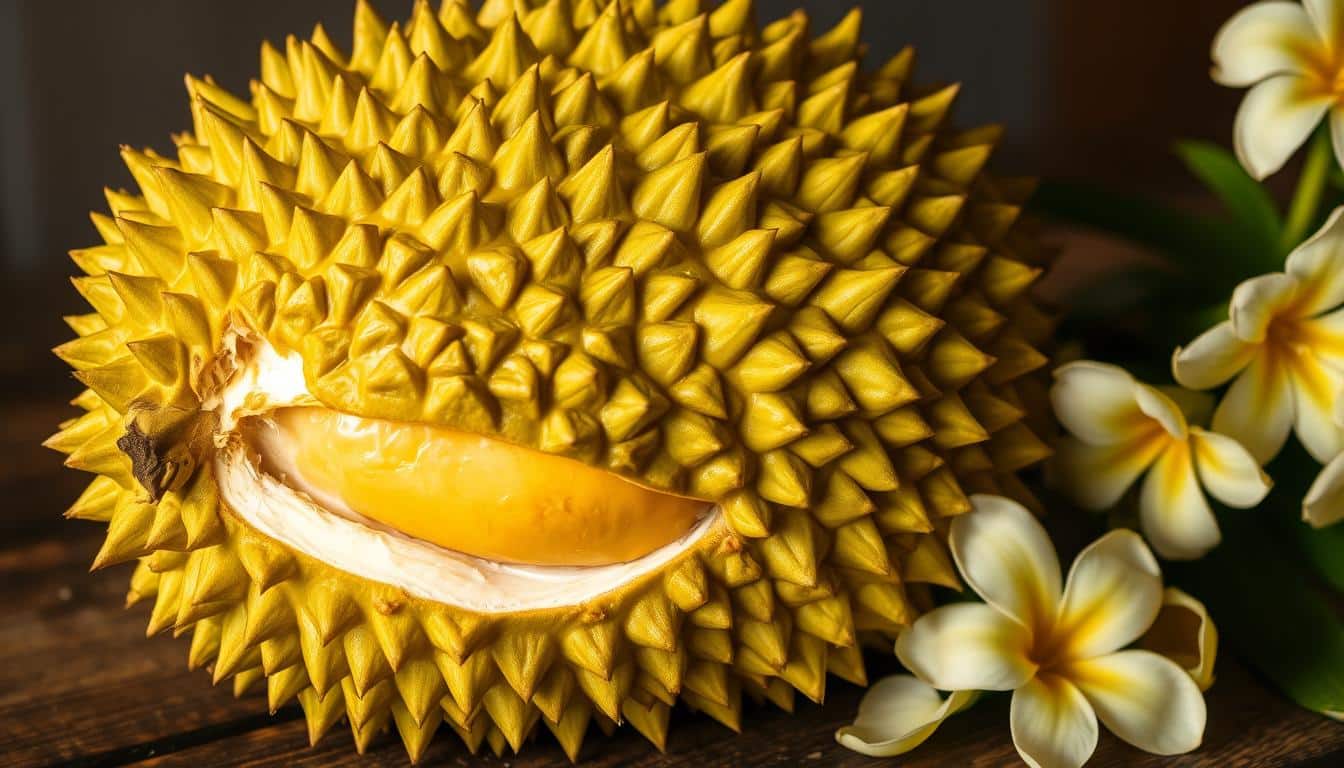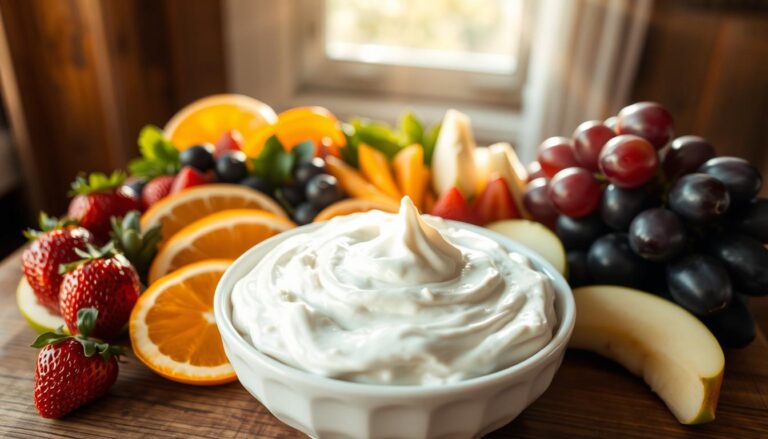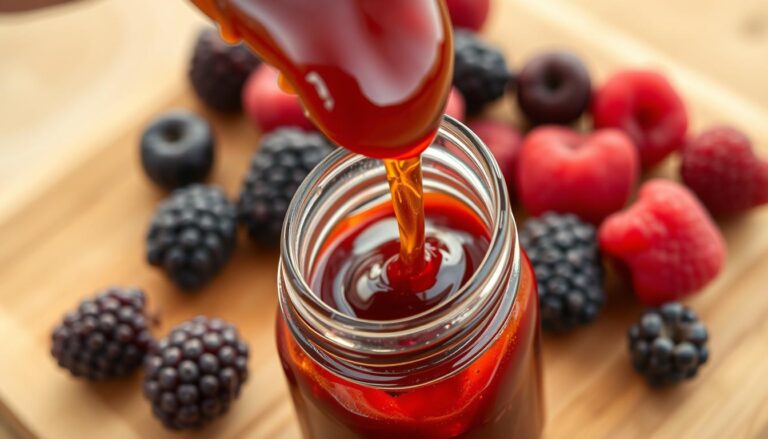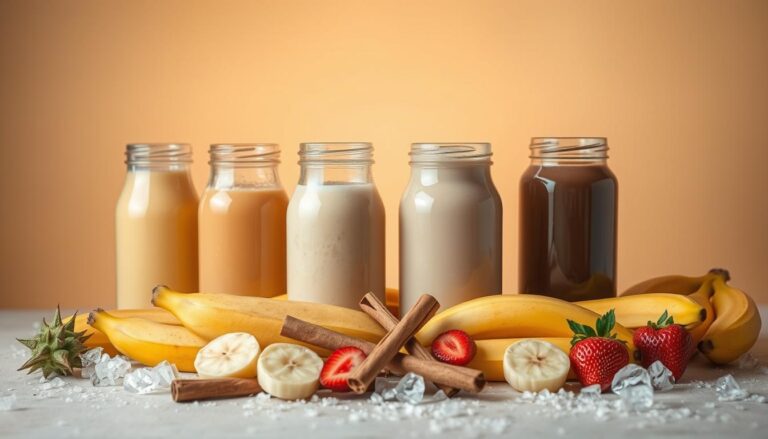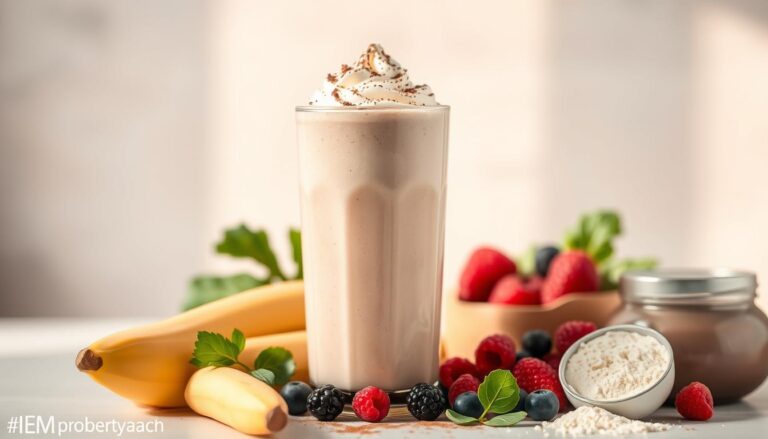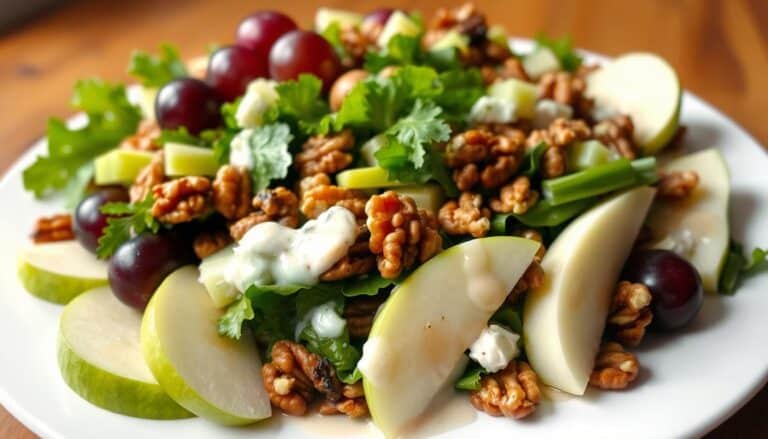Durian Fruit Why 7 People Love And Others Avoid It
Welcome to the world of durian fruit, a culinary marvel that sparks debates worldwide. Known as the king of fruits in Southeast Asia, it’s celebrated and controversial. Your journey into understanding this unique fruit begins here.
Imagine a fruit so powerful it’s banned from public transport, hotels, and many indoor spaces. The durian fruit isn’t just another tropical treat—it’s a sensory experience. It divides food enthusiasts into two camps: those who are utterly obsessed and those who run in the opposite direction.
What makes this king of fruits so special? Its distinctive aroma, which some find heavenly and others unbearable, sets durian apart. From its spiky exterior to its creamy interior, the durian fruit challenges everything you thought you knew about taste and smell.
Key Takeaways
- Durian fruit is known as the most controversial tropical delicacy
- The fruit has a powerful aroma that divides food lovers
- Originates from Southeast Asian regions
- Banned in many public spaces due to its strong smell
- Considered a delicacy with complex flavor profiles
The Legendary King of Fruits: An Introduction to Durian
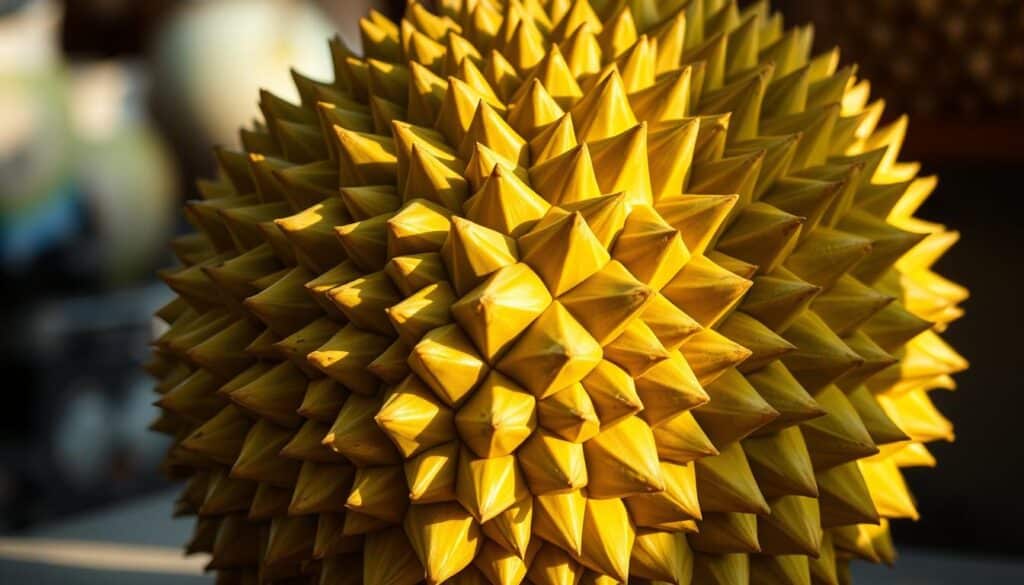
Get ready to dive into the world of a tropical treat that sparks debate and curiosity in Southeast Asia. Durian is a fruit with a big reputation, fascinating food lovers and the brave around the globe.
This fruit is more than just a food item. It’s a cultural phenomenon that surprises and delights those who try it. It’s a fruit that people both love and fear, and it’s even banned in some places.
Cultural Significance in Southeast Asia
In places like Malaysia, Indonesia, and Thailand, durian is a big deal in food traditions. People celebrate it with:
- Annual durian festivals
- Traditional dessert preparations
- Street vendor specialties
- Family gathering centerpieces
The Controversial Reputation
Durian’s fame comes from its strong smell and unique taste. Some say it’s heavenly, while others find it too much. Its smell is so strong that it’s banned in many places, like hotels and buses.
Why It’s Called the King of Fruits
The “King of Fruits” title comes from its size, unique look, and cultural value. Durian stands out with its big spiky skin and creamy inside. Its rich, custard-like flesh and complex taste make it a true fruit king.
Understanding the Unique Aroma: Science Behind the Smell
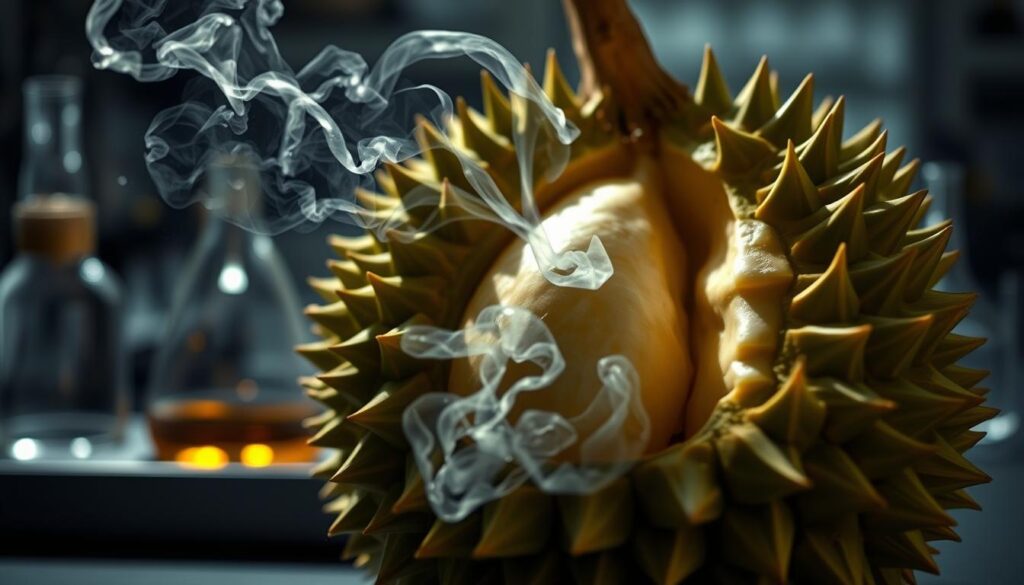
Durian, known for its strong smell, has caught the world’s eye. Scientists are trying to figure out why this fruit’s smell is so powerful. They want to know why it can clear out a room.
Researchers found several key chemicals that make durian smell so bad. These chemicals are so strong that many places ban durian.
- Methanethiol: A sulfur-containing compound generating rotten egg-like odors
- Diethyl disulfide: Contributes to the pungent onion-like smell
- Propanoic acid: Adds a sweaty, acidic note to the overall fragrance
How you experience durian’s smell can vary. Some people hate it, while others love it. This difference comes from how our genes affect our sense of smell.
| Chemical Compound | Odor Characteristic | Intensity Level |
|---|---|---|
| Methanethiol | Rotten eggs | High |
| Diethyl disulfide | Onion-like | Medium |
| Propanoic acid | Sweaty | Low |
The smell of durian changes as it ripens. This change makes its smell even more interesting to scientists and food lovers around the world.
Durian Fruit: Physical Characteristics and Varieties
Durian is a unique tropical fruit known for its distinctive look and amazing traits. Its thick, spiky shell hides a creamy inside. Let’s explore its physical traits and popular varieties.
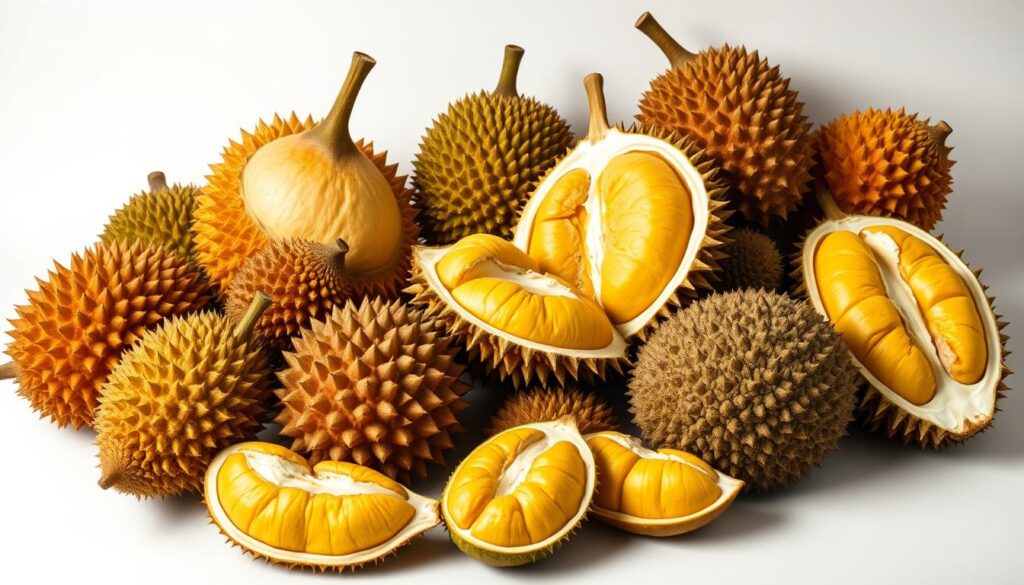
Durian comes in many varieties, each with its own flavor and texture. Monthong durian and musang king are two top choices, loved for their unique qualities.
Popular Durian Cultivars
- Monthong Durian: From Thailand, it’s known for its mild taste and creamy texture
- Musang King: A favorite in Malaysia, it’s famous for its strong flavor and custard-like flesh
- D24: Known for a sweet and bitter taste
- Black Thorn: A premium variety with a deep golden color
How to Choose Ripe Durian
Choosing the right durian needs careful observation. Here’s how to tell if it’s ripe:
- Shake the fruit – you should hear seeds moving inside
- Check for a strong, sweet aroma
- Examine the stem – it should be dark and slightly soft
- Look for minimal brown spots on the exterior
Storage and Handling Tips
Storing durian right is key to keeping it fresh. If you’ll eat it in a day, keep it at room temperature. For longer, refrigerate and eat within 2-3 days.
| Variety | Origin | Flavor Profile | Price Range |
|---|---|---|---|
| Monthong Durian | Thailand | Mild, Creamy | $15-$25/kg |
| Musang King | Malaysia | Intense, Rich | $30-$50/kg |
| D24 | Singapore | Balanced Sweet-Bitter | $20-$35/kg |
Knowing these traits will make exploring durian exciting and rewarding.
The Love Affair: Why Durian Enthusiasts Can’t Get Enough
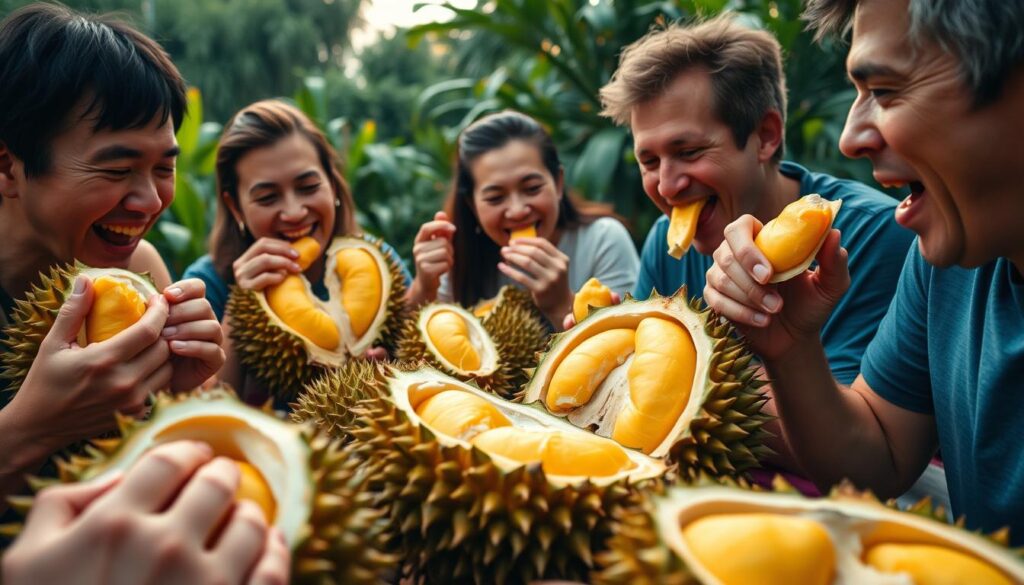
Durian fans are not just casual eaters. They are deeply passionate about a unique culinary adventure. The fruit’s creamy texture offers a journey that fascinates true lovers.
So, why do people fall in love with durian? Let’s look at what makes it so special:
- Unique custard-like texture that melts in your mouth
- Complex flavor profile with sweet and savory notes
- Rich, creamy consistency unlike any other fruit
- Intense sensory experience that challenges traditional taste expectations
Durian is seen as a delicacy, like fine cheese or truffles. Its creamy texture makes it stand out from other fruits.
For durian lovers, it’s more than just eating. It’s a cultural celebration. The fruit’s unique taste and texture have created a devoted following.
Whether you’re new to durian or already a fan, understanding its appeal can change how you see this amazing fruit.
Health Benefits and Nutritional Value
Durian is more than a unique fruit with a memorable smell. It’s a nutritional powerhouse with amazing health benefits. This tropical fruit is full of nutrients that can greatly improve your health.
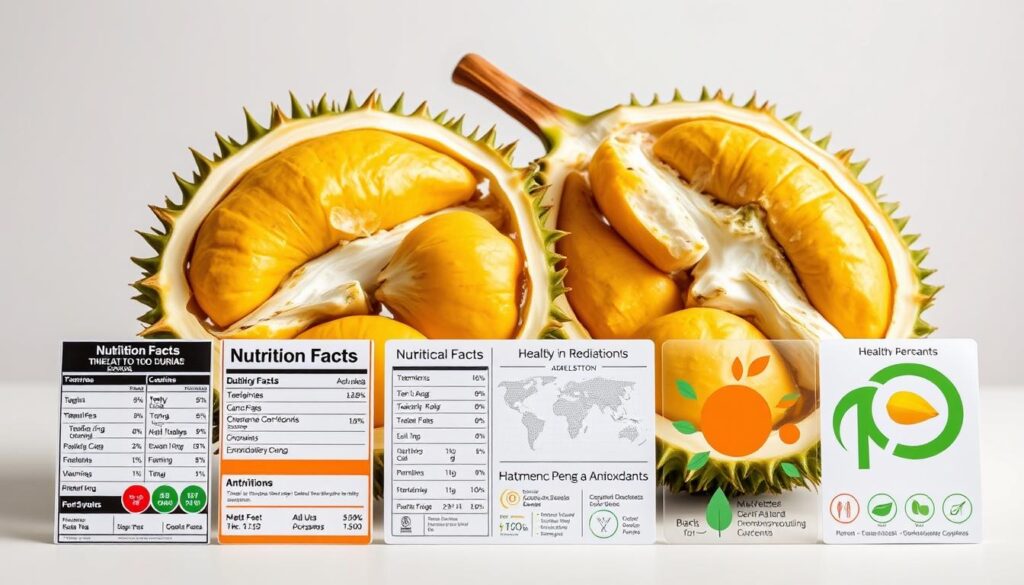
Exploring durian’s health benefits reveals a fruit that’s more than its infamous smell. Its nutritional profile makes it a great choice for those who care about their health.
Vitamins and Minerals Content
Durian is packed with essential nutrients. Here’s why it stands out:
- Rich in vitamin C for immune support
- High potassium content for heart health
- Significant amounts of vitamin B complex
- Provides essential minerals like magnesium and copper
Digestive Health Properties
Your digestive system will appreciate durian. It has a lot of dietary fiber. This helps keep your gut healthy and supports regular bowel movements.
Antioxidant Properties
Durian’s antioxidants are impressive. Polyphenols and flavonoids in the fruit fight free radicals. This may reduce inflammation and support cell health.
While durian has many health benefits, remember to eat it in moderation. It’s high in calories and sugar. So, enjoy it as part of a balanced diet.
Common Reasons Why People Avoid Durian
Durian, known for its strong smell, is often avoided. Its unique traits can be overwhelming at first. This tropical fruit has a reputation that makes many people hesitant to try it.
The smell of durian is its biggest challenge. It smells like sweaty socks, rotten onions, and something else hard to describe. This smell is so strong that many places in Southeast Asia ban durian.
- Powerful and offensive smell that lingers
- Extremely challenging exterior with sharp spikes
- High-fat content that may cause digestive discomfort
- Acquired taste that not everyone appreciates
The durian’s look is another barrier. Its exterior is covered in sharp spikes. This makes it hard and risky to open. You need special tools and skill to open it safely.
Some people worry about how durian affects their stomach. It has a lot of fat and complex sugars. These can cause bloating or stomach issues in some people.
Not knowing about durian also keeps people away. For those outside Southeast Asia, it’s an exotic and scary food. Many are hesitant to try it because of this.
Cultural Beliefs and Traditional Uses
Durian is a unique fruit with deep cultural roots in Southeast Asia. It’s known for its distinct taste and smell. But it’s also tied to centuries of stories, traditions, and beliefs.
Durian’s cultural story is as rich as the fruit itself. Communities across the region see it as more than just a fruit. It’s a symbol of their identity.
Medicinal Applications
Traditional healers value durian for its health benefits. In Southeast Asia, it’s seen as a fruit with healing powers:
- Boosting energy and stamina
- Supporting digestive health
- Enhancing blood circulation
- Potentially improving mood and emotional well-being
Folklore and Legends
Stories about durian’s origins are captivating. In the Philippines, it’s called a cursed fruit with magical powers. Indonesian tales say it’s an aphrodisiac, adding to its mystique.
Modern Cultural Impact
Today, durian shapes art, food, and social norms. It’s found in fancy restaurants and street stalls. This fruit connects old traditions with new experiences.
Creative Ways to Enjoy Durian: Beyond Fresh Consumption
Durian fruit is more than just a tropical treat. It’s a versatile ingredient that sparks creativity in kitchens worldwide. Food lovers and chefs have found many ways to use it.
There’s more to durian than just eating it fresh. Chefs and home cooks have found exciting ways to use it. They’ve made:
- Creamy durian fruit ice cream
- Rich and decadent durian cheesecakes
- Smooth durian mousses
- Delicate pastries and tarts
- Unique milkshakes and smoothies
Baking fans can try durian in cakes. It makes desserts moist and flavorful. Some bakeries even make pastries filled with durian.
Savory dishes also get a boost from durian. Chefs use it in sauces, as a filling for spring rolls, or in marinades. Its rich texture adds a unique twist to dishes.
Durian inspires both traditional and modern recipes. It’s a journey for your taste buds. Get ready for an adventure!
Safety Precautions and Considerations
When you enjoy this spiky Southeast Asian fruit, you must be careful. It has unique challenges that everyone should know before trying it. Its special flavor is worth the effort, but safety comes first.
People with certain health issues need to be extra careful. If you have kidney problems, durian’s high potassium can be a risk. Always check with your doctor before trying new foods.
- Avoid durian if you have kidney disease
- Consult your healthcare provider for personalized advice
- Monitor your intake if you have diabetes
Handling durian requires care. Wear protective gloves when cutting it to avoid injuries. The thorny exterior is not to be underestimated.
| Health Consideration | Recommendation |
|---|---|
| Kidney Issues | Limit or avoid consumption |
| Low-Carb Diet | Calculate carbohydrate content carefully |
| Blood Sugar Management | Monitor glucose levels after eating |
Storage is crucial for maintaining durian’s safety and quality. Always refrigerate fresh durian and eat it within 2-3 days. Check for spoilage signs like bad smells or color changes before eating.
Your health and safety should always come first when enjoying this fruit. Learn about its nutritional value and how it might affect your health. This way, you can enjoy durian safely and responsibly.
Durian Festivals and Celebrations Worldwide
Explore the lively world of durian festivals that unite people during the peak season. These events show the fruit’s importance and give special experiences for everyone.
Durian fans worldwide have set up fun events to celebrate this special fruit. You’ll find everything from vibrant street markets to big cooking contests. These festivals show the deep love for the king of fruits.
Famous Durian Events
- Chanthaburi Durian Festival (Thailand): An annual extravaganza that attracts thousands of visitors
- Malaysia’s Durian Buffets: All-you-can-eat celebrations during peak durian season
- Singapore’s Durian Parties: Showcasing the most exotic durian varieties
Tourism Impact
These festivals are more than just fruit celebrations. They also help local economies grow. Small towns become lively spots that attract food fans and culture seekers from everywhere.
Local sellers, farmers, and shops gain from the extra visitors. The festivals bring:
- Cultural exchange opportunities
- Economic boost for local communities
- Unique culinary experiences
Whether you love durian or just want to try something new, these events are unforgettable. The durian season is filled with joy, community, and food adventures.
Environmental Impact and Sustainable Farming
Durian farming faces unique challenges and chances for the environment. As more people want this exotic fruit, farmers are finding new ways to farm sustainably. They aim to protect nature and keep farming productive.
To grow the king of fruits sustainably, farmers use several key methods:
- Biodiversity conservation in plantation areas
- Reduced chemical pesticide usage
- Water-efficient irrigation systems
- Soil health management
In Southeast Asia, farmers are using agroforestry. They plant durian trees with other plants. This keeps the ecosystem balanced and makes farms stronger.
It’s important to adapt to climate change for durian farming. Farmers pick strong plants and use new ways to watch over their farms. This helps avoid problems with the king of fruits.
People are coming together to make farming better. They focus on:
- Organic farming certifications
- Reducing carbon footprint
- Keeping natural habitats safe
- Helping local wildlife
By going green, durian farmers make sure this special fruit can be enjoyed for years to come. They also protect the environment.
Where to Find and How to Buy Quality Durian
Finding the perfect durian is an art. Whether you’re a durian expert or new to it, knowing where to find top-quality durian makes a big difference.
Finding durian can be tough, even more so during durian season. The Musang King is the most loved and sought-after durian variety.
Seasonal Availability Insights
Durian season is from June to August in Southeast Asia. The best fruits are available during this time. Here are some tips for buying:
- Check local farmers markets for fresh produce
- Look for specialized Asian grocery stores
- Consider online specialty fruit retailers
- Verify the exact harvest dates for optimal freshness
Price Considerations
Durian prices change a lot. The Musang King is pricier because of its great taste and creamy texture. Here’s how to buy:
- Compare prices from multiple vendors
- Understand quality grading systems
- Consider purchasing during peak durian season for better rates
- Factor in shipping costs for imported fruits
Pro tip: Real Musang King durians cost between $20 to $50 per kilogram. Quality and availability affect the price. Always buy from trusted sellers for the best fruit.
Conclusion
Durian is more than just a fruit; it’s a tropical delicacy that challenges our views. It invites us to see beyond its tough skin and strong smell. Durian is not just food; it’s a cultural experience that connects traditions and personal tastes.
Durian, known as the king of fruits, fascinates people all over the world. Its unique taste and health benefits make it a special culinary journey. Understanding durian shows us its deep cultural value and culinary possibilities, unlike any other fruit.
Exploring durian teaches us that food is about more than taste. It’s about experience, tradition, and discovering new things. By trying durian, we open up to different food cultures and challenge our own ideas about exotic foods.
Durian encourages us to be open to new foods with an open mind. Whether you love it or just find it interesting, durian will leave a lasting memory in your food journey.

